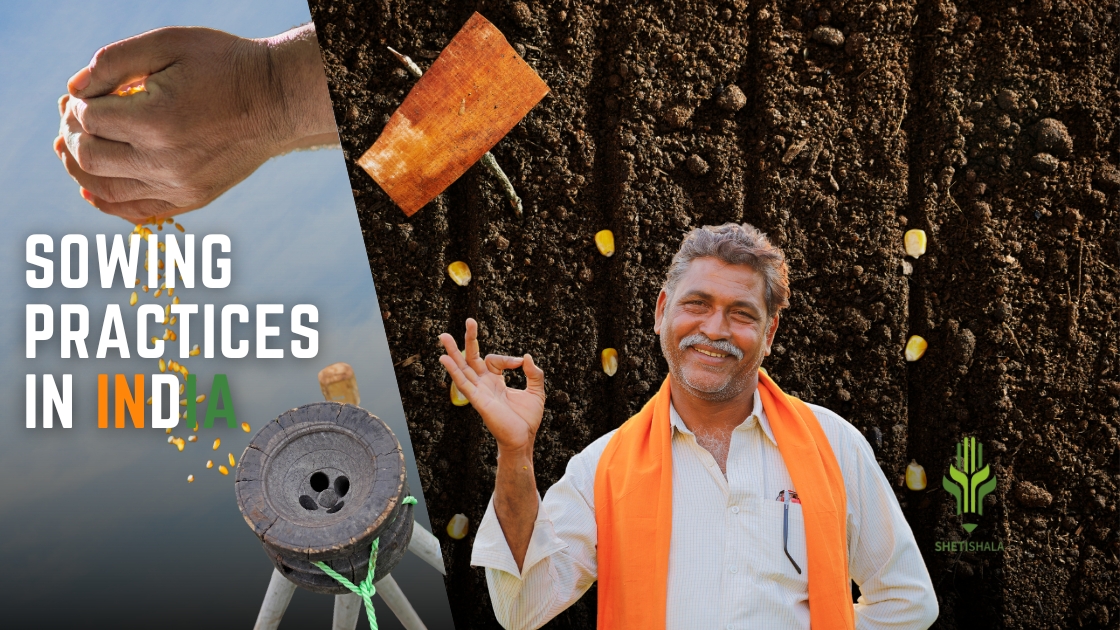Introduction
Sowing practices in India have evolved from traditional methods like broadcasting and dibbling to modern sowing practices, including precision farming and mechanized seed drills. Traditional sowing practices often rely on local knowledge and manual labor, while modern techniques aim to enhance efficiency and yield. Sowing seasons in India vary by region, with kharif and rabi being the primary seasons. However, farmers face challenges such as climate variability, soil degradation, and limited access to advanced technology. Solutions like improved irrigation, adoption of sustainable practices, and government support can help overcome these challenges and boost agricultural productivity across the country.

Here’s an overview of the key points:
Sowing Seasons
1. Kharif Season (June to October)
– Crops: Rice, maize, soybeans, cotton, and millets.
– Timing: Sowing begins with the onset of the monsoon in June and continues until July.
2. Rabi Season (October to March)
– Crops: Wheat, barley, peas, mustard, and gram.
– Timing: Sowing starts after the monsoon rains end, around October-November.
3. Zaid Season (March to June)
– Crops: Cucumbers, vegetables, and fodder crops.
– Timing: Sown between the rabi and kharif seasons.
Factors Influencing Sowing
1. Climate and Rainfall:
The timely arrival of the monsoon is critical for the kharif season. Rabi crops
depend on the residual moisture from the monsoon and irrigation facilities.
2. Soil Type:
Different crops require different soil types, affecting the sowing decisions
3. Irrigation Facilities:
Areas with good irrigation can support multiple cropping seasons.
Sowing Techniques
1. Broadcasting:
Scattering seeds by hand or mechanically.
2. Drilling:
Sowing seeds in rows using seed drills.
3. Transplanting:
Raising seedlings in nurseries and then planting them in the field (common for crops
like rice).
Challenges
1. Monsoon Variability:
Delayed or inadequate monsoon can disrupt sowing schedules.
2. Soil Health:
Degradation and loss of fertility can affect crop yields.
3. Pest and Disease Management:
Effective management practices are required to protect the crops.
Modern Trends
1. Precision Farming:
Use of technology like GPS and data analytics to optimize sowing.
2. Sustainable Practices:
Emphasis on organic farming and conservation agriculture.
Government Initiatives
1. Pradhan Mantri Krishi Sinchai Yojana (PMKSY):
To improve irrigation facilities.
2.National Food Security Mission (NFSM):
To increase the production of rice, wheat, pulses, and
coarse cereals.
Sowing Practices
Understanding these factors helps in better planning and execution of sowing practices, leading to
improved agricultural productivity in India.
Sowing practices in agriculture involve the methods and techniques used to plant seeds. These practices
vary based on crop type, soil conditions, climate, and available technology.
Below are common sowing practices used in India:
Traditional Sowing Practices

1. Broadcasting
– Method:
Seeds are scattered by hand or using a broadcaster.
– Advantage:
Simple and quick.
– Disadvantages:
Uneven seed distribution, higher seed requirement, and competition among plants.
2. Dibbling
Method: Seeds are placed in holes made at specific distances in the soil.
– Advantages:
Precise placement, better spacing, and lower seed rate.
– Disadvantages:
Labor-intensive and time-consuming.
3. Transplanting
– Method:
Seeds are initially sown in a nursery and seedlings are later transplanted to the main field.
– Advantages:
Better plant establishment and uniform crop growth.
– Disadvantages:
Labor-intensive and higher costs.
Modern Sowing Practices
1. Line Sowing (Drilling)
– Method:
Seeds are sown in rows using seed drills or planters.
– Advantages:
Uniform seed depth and spacing, better crop management.
-Disadvantages:
Requires equipment and technical know-how.
2. Zero Tillage
– Method:
Seeds are sown directly into the unplowed field, minimizing soil disturbance.
– Advantage:
Reduces soil erosion, conserves moisture, and lowers labor and fuel costs.
– Disadvantage:
Initial investment in machinery and potential challenges with weed control.
3. Precision Sowing
– Method:
Uses advanced technologies like GPS and sensors to sow seeds at precise depths and
intervals.
– Advantages:
Maximizes yield, reduces seed wastage, and optimizes input use.
– Disadvantages:
High initial cost and requires technical expertise.
Sowing Equipment
1. Seed Drill-
– Used for line sowing.
– Ensures uniform depth and spacing.
2.Transplanter
– Mechanizes the transplanting process.
– Commonly used for rice.
3. Planter
– Advanced version of seed drills with precise metering and placement mechanisms.
– Used for crops like maize and cotton.
Best Practices for Sowing
1. Soil Preparation
– Plowing, harrowing, and leveling to create an optimal seedbed.
– Ensures good seed-soil contact.
2. Seed Treatment
– Treating seeds with fungicides or insecticides to protect against pests and diseases.
– Enhances germination and seedling vigor.
3. Optimal Sowing Depth and Spacing
– Ensures adequate sunlight, nutrients, and water for each plant.
– Prevents competition and maximizes yield.
4. Timely Sowing
– Sowing at the right time based on the crop and local climate.
– Aligns with favorable weather conditions for germination and growth.
Challenges and Solution
1. Climate Variability
– Adaptable sowing times and resilient crop varieties.
– Use of weather forecasting tools.
2. Soil Health
– Regular soil testing and use of organic amendments.
– Crop rotation and cover cropping to maintain soil fertility.
3. Pest and Disease Management
– Integrated Pest Management (IPM) practices.
– Use of resistant crop varieties and biological controls.
By adopting appropriate sowing practices and modern technologies, farmers can enhance crop
productivity, sustainability, and profitability.
Which Sowing Method Gives Higher Productivity?

The sowing method that generally gives higher productivity depends on various factors such as the crop
type, soil conditions, climate, and available resources. However, modern sowing methods like precision
sowing and line sowing (drilling) tend to provide higher productivity due to their accuracy and efficiency.
Here’s a closer look at why these methods are more productive:
1. Precision Sowing
Method:
Uses advanced technologies like GPS, sensors, and automated equipment to sow seeds at precise
depths and intervals.
– Advantages:
– Uniform Seed Placement: Ensures optimal spacing, reducing competition for nutrients, light, and water.
– Efficient Resource Us: Minimizes seed wastage and optimizes input usage (e.g., fertilizers and water).
– Enhanced Crop Management: Allows for better weed, pest, and disease management.
– Outcome: Higher germination rates, healthier plant growth, and increased yields.
2. Line Sowing (Drilling)
Method:
Seeds are sown in rows using seed drills or planters.
– Advantages:
– Consistent Seed Depth: Ensures even germination and growth.
– Improved Crop Management: Easier to apply fertilizers, irrigate, and control weeds.
– Better Air Circulation: Reduces the risk of fungal diseases.
– Outcome: More uniform crops and higher productivity compared to traditional methods like
3. Broadcasting
Comparative Advantages of Modern Sowing Methods
– Efficiency:
Both precision sowing and line sowing ensure seeds are placed at the optimal depth and
spacing, leading to better germination and plant growth.
-Resource Management:
These methods enable efficient use of seeds, fertilizers, and water, reducing
waste and cost.
– Yield Improvement:
By optimizing growing conditions, these methods typically result in higher yields.
– Scalability:
Modern methods can be easily scaled up for large farms, making them suitable for both
small and large-scale operations.
Supporting Evidence
Research and field studies have shown that these modern sowing methods can significantly improve crop
yields.
Example:
– Precision Sowing:
Studies have demonstrated yield increases in crops like maize, wheat, and soybeans
when using precision agriculture techniques.
– Line Sowing:
Particularly in crops like rice and wheat, line sowing has been found to result in higher
yields compared to broadcasting due to better crop management and reduced competition among plants.
Conclusion
While traditional methods like broadcasting and dibbling are still widely used due to their simplicity and
lower cost, modern sowing techniques such as precision sowing and line sowing (drilling) generally offer
higher productivity. These methods improve resource efficiency, ensure uniform crop growth, and
facilitate better crop management, ultimately leading to higher yields and greater profitability for farmers.
For more such interesting information visit out blogs –
Biotechnology and Biotechnology application in agriculture
Nanotechnology and Application of nanotechnology in Agriculture




